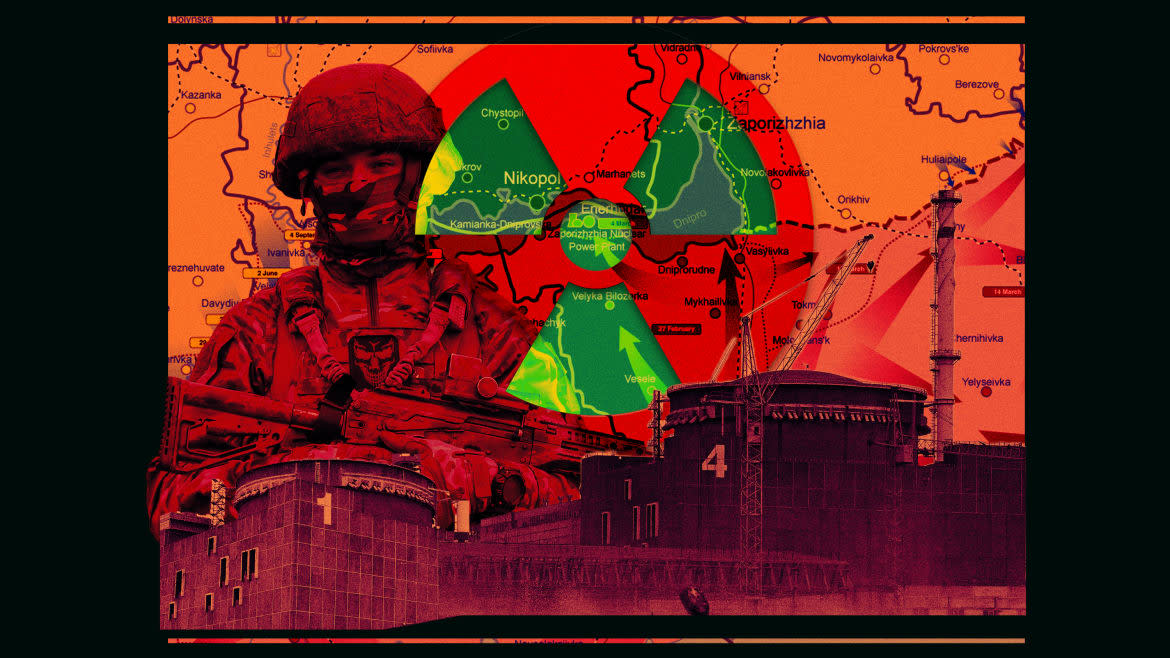Ukraine’s Ticking Nuclear Time Bomb

- Oops!Something went wrong.Please try again later.
Of all the horrors of Putin’s war on Ukraine, the most disastrous might be his constant threat to Europe’s largest nuclear power plant.
The Zaporizhzhia plant is a ticking nuclear time bomb. Through accident, attack, or sabotage it could become the worst nuclear catastrophe since Chernobyl.
Concerns are rising as Ukraine prepares to launch its counter-offensive, which will likely involve intense fighting around the nuclear site.
Trump and Putin Are in Deep Trouble and Need Each Other More Than Ever
Energoatom, Ukraine’s state nuclear company, warned that the plant is “on the verge of a nuclear and radiation accident.” The IAEA said the facility is “extremely vulnerable.” Workers at the facility told Britain’s Sky News that they feared that the fighting could trigger the release of radioactive gasses that “could cause devastation across much of Europe, Russia, and the Mediterranean.”
The risk is not of a nuclear explosion like Hiroshima or Nagasaki. The danger comes from the thousands of fuel rods at the plant that could melt down, releasing hydrogen gas that then explodes, spewing radioactive particles in plumes that could travel hundreds or even thousands of miles.
Think “nuclear Hindenburg.”
In addition to the hundreds of tons of fuel in the six nuclear reactors at the site, there are more than 3,300 spent fuel assemblies in dry storage outside the reactors, and almost 2,000 in pools. That is a total of 2,200 tons of nuclear material. Much of this fuel is hot. It needs to be constantly cooled. If electricity is cut off, the pumps cannot circulate the water, the fuel rods will heat up and explode.
Thus far, the electric power to the plant has been cut off seven times since Vladimir Putin invaded Ukraine, most recently on May 6. Backup generators kicked in to keep the water circulating until the power could be restored. But these generators can only work for a few days, if they are in good repair.
For months, I and other experts have warned that Zaporizhzhia was hanging by a thread. Here is how that thread might be cut:
1. Fighting around the plant cuts the power lines or knocks out the power supply.
This is the most likely scenario, particularly as the coming Ukrainian offensive is likely to try to advance across the Dnipro River and drive Russian occupying forces from the Zaporizhzhia region. One worker told Sky News that the backup generators were not being properly maintained, and he feared that they could not keep the power going.
2. Staff mistakes could trigger a disaster, as they did at Chernobyl and Three Mile Island.
Since Russia occupied the plant in March 2022, the number of workers has dropped from 11,000 to about 3,500. Worse, “the quality of the workers is lower because the qualified staff left,” one worker said. There is now a “deficit of workers for repairs who can actually do the servicing and fix problems.”
3. A deliberate Russian attack could drain the pools or destroy the concrete domes around the reactors.
A Ukrainian attack is unlikely—this is why Russia has now stored scores of military vehicles and munitions at the plant—but this is war and a stray missile or shell could hit a critical node.
4. There is also the possibility that Russia would sabotage the plant.
The Russian military could intentionally destroy the plant in order to delay or defeat the Ukrainian advance. There are unconfirmed reports that Russia has planted explosives around key nuclear components at the site. Russia has begun mass evacuations around the plant.
“We are fortunate that a nuclear accident has not yet happened,” IAEA Director General Rafael Mariano Grossi warned the United Nations Security Council on May 30. “We are rolling the dice and if this continues then one day our luck will run out.”
What Happens to Russia After It Loses?
Grossi has renewed his call for immediately demilitarizing the plant and the surrounding area. Russia refused, as it has since it began its occupation.
There is little sign that Putin will change his mind. He wants to keep a plant that once supplied 20 percent of Ukraine’s energy as a nuclear ace in the hole that he could play. It is an integral part of his game of nuclear chicken.
But there is no winning hand here. It is not only Ukrainian drones that can reach Moscow. Winds could carry the radioactive plumes from smoldering Zaporizhzhia fires deep into Russia. A move intended to harm Ukrainians could instead sow new panic among Russians supporting Putin’s war.
At this point, we would have to say that the odds of just such a disaster are better than even. The nuclear time bomb is ticking.
Get the Daily Beast's biggest scoops and scandals delivered right to your inbox. Sign up now.
Stay informed and gain unlimited access to the Daily Beast's unmatched reporting. Subscribe now.

